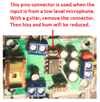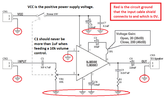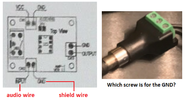To everybody, helping out. I really appreciate all the advice. When the system is using Bluetooth, the hum isn't bad and I'm fine with the current state of my system, but would of course like to eliminate it, if possible, but this isn't a big deal. I'm also learning about circuits and electronics from all the replies. With all of that in mind, things are getting weird though:
audioguru "Simply disconnect the non-shielded input wires and listen to the hum disappear."
Unfortunately, disconnecting the non-shielded input wires makes the situation worse. Not only does the hum remain before I power on the Bluetooth receiver, it also doesn't go away once I power it on, as it does when it's connected. Does this shed any light on the situation? For best practices, I may replace it with shielded audio cable, but I'm not confident this will eliminate the hum.
Nigel Goodwin - ty 4 the terminology correction regarding my incorrect use of the term "splitter."
rjenkinsgb "OK, that is an ungrounded power unit." Can you please elaborate. My initial description was incorrect. The AC adaptor is only a 2-prong adapter, but if it were a 3-prong adapter, I don't understand why it would be considered ungrounded.
audioguru "
Your photo has a pins connector on the amplifier that is used when the input is from a low level microphone.
With a guitar, the connector should be removed because it increases the gain then hiss and hum are increased."
I have some familiarity with the board, and if I remove the jumper, this decreases the voltage gain from 46 dB to 26dB. I just removed both jumpers and I much prefer the sound with the extra gain. With the jumpers disconnected and the system powered on without the Bluetooth unit powered on, the hum is still present. It may be a tiny drop less, but irrelevant to me.
rjenkinsgb "I would suggest keeping them away from the power connections though - where they must cross, try to keep some separation and the two different sets of wires at right angle rather than near parallel."
Ty -I may try this. Right now, the wires are literally on top of each other.
audioguru - regarding your suggestion to lower the voltage. I can try a 9V power supply instead. Maybe I'm wrong, but I do feel as if I prefer the system with 12V. It seems more powerful to me than when I ran it with 9V batteries, even the few minutes when I got the actual 9.72V from fresh ones. Maybe I like noise and imperfection.

I think I've covered everything.





